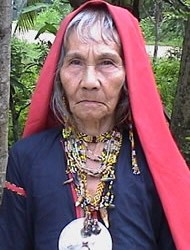Mandaya in Philippines

Photo Source:
Al Hoopes
|
Send Joshua Project a map of this people group.
|
| People Name: | Mandaya |
| Country: | Philippines |
| 10/40 Window: | No |
| Population: | 288,000 |
| World Population: | 288,000 |
| Primary Language: | Mandaya |
| Primary Religion: | Ethnic Religions |
| Christian Adherents: | 9.00 % |
| Evangelicals: | 2.00 % |
| Scripture: | Translation Started |
| Ministry Resources: | No |
| Jesus Film: | No |
| Audio Recordings: | Yes |
| People Cluster: | Filipino, Tribal |
| Affinity Bloc: | Malay Peoples |
| Progress Level: |
|
Introduction / History
The Mandaya community has resisted colonialists and outsiders for centuries. They are located in the Davao Oriental province on Mindanao, in the southern Philippines.
What Are Their Lives Like?
The Mandaya people have their own unique culture which they express through weaving, music and dance. They play various instruments including the flute, bamboo zither and gong. Their weaving skills produce textiles and skirts they call a dawot for women and a bahag loincloth for men. There is an effort to promote tourism in their homeland so the Mandaya people can earn a better living.
What Are Their Beliefs?
Though they live in a part of the Philippines where there is a Muslim majority, the Mandaya retain their own ethnic religious system.
What Are Their Needs?
They need their homeland and their culture protected against outsiders.
Prayer Points
Pray for the Lord to bless this community economically and spiritually.
Ask God to raise up Mandaya who are more desirous to know the truth than to stay on the broad road.
Ask God to send loving, committed workers to the Mandaya in the near future.
Pray the Mandaya would no longer be hidden away from the influence of Christ.
Pray for many of them to make disciples who will make even more disciples.